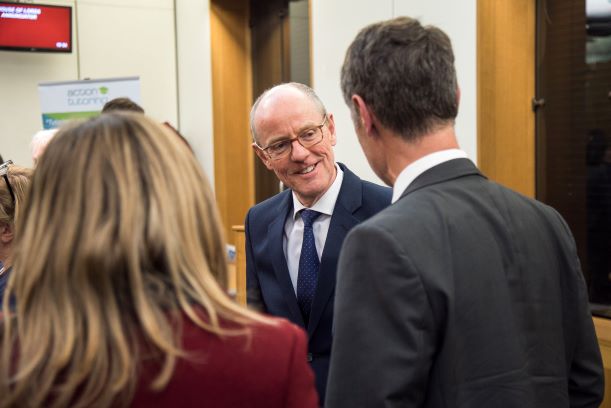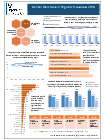More must be done to make £130 million a year Teacher Recruitment & Retention Strategy a success

Increase teacher starting salaries to make the profession competitive
Commenting on the School workforce in England statistics from the Department for Education, Russell Hobby, Chief Executive of Teach First said:
“It’s hugely concerning to see a fall in the number of secondary school teachers, despite pupil numbers set to rapidly rise. If we don’t address this head on more children will simply not get the fair education they deserve – and it will be pupils in the poorest communities who will suffer the most.
“If the next Prime Minister wants the country to thrive, they must urgently address this by increasing teacher starting salaries to make the profession competitive with others. Great teachers are crucial to the future of our country and if we want to see more join, they must be fairly rewarded for the incredible difference they make each and every day.”
Kevin Courtney, Joint General Secretary of the National Education Union, said:
“This latest data shows the unacceptable consequences of the school funding crisis and the numbers of teachers being driven out of the profession through the Government’s failure to address workload and teacher pay. Teacher recruitment continues to lag behind increases in pupil numbers, resulting in fewer teachers per pupil. In secondary schools, full-time equivalent teacher numbers have fallen by over 10,000 in the last four years, despite an increase of almost 150,000 pupils. Teaching assistant numbers in secondary schools also continue to fall, by 3% in the last year alone and by over 15% in the last five years.
“In both primary and secondary sectors, the proportion of pupils in classes of more than 30 continues to rise; it now stands at 13% (558,658 in primary, 402,469 in secondary). Average secondary class sizes continue to rise at their fastest ever rate, while the average class size in primary remains at its highest level since 2000. The number of secondary pupils in large classes is at its highest level since 1981. This is clearly bad for the education of children and young people and needs to be urgently addressed.
“Teacher retention rates at all career stages continue to decline, with an increasing proportion of recent recruits and more experienced teachers leaving the profession. Almost a third of teachers (32.3%) have left the sector five years after qualifying, up from just over a quarter (26.0%) seven years ago. Average teacher pay continues to lag behind inflation, meaning that the real value of teacher pay continues to decline.
“Today, in the Public Accounts Committee’s annual report Chair Meg Hillier MP has said the Department for Education now ‘tops my departments of concern.’ The mismanagement and underfunding of our schools is now undeniable.
“With the latest report from the School Teachers’ Review Body still to be published by the Government, teachers and parents will be looking for urgent and effective action from the Government to enable schools to recruit and retain the teachers we need. That means additional resources to reverse the real-terms cuts to school funding. It also means reversing the pay cuts that have hit those working in education and reducing the excessive hours worked by teachers and other school staff.
“The NEU will continue to campaign for the additional school funding and better pay and working conditions needed to secure a first-class education service for pupils and parents.”
Minister for School Standards Nick Gibb said:
“The number of teachers in our schools remains high, with more than 453,000 now working in schools across the country to inspire the next generation of young people. Last year also saw an additional 34,500 new trainee teachers recruited, despite an extremely competitive labour market and the lowest levels of unemployment for decades, showing that teaching continues to be an attractive profession.
“We do recognise there is more to do to continue to attract and retain talented individuals in our classrooms, which is why we launched the first-ever Teacher Recruitment & Retention Strategy earlier this year. This landmark strategy included the biggest teaching reform in a generation – the Early Career Framework – providing the solid foundations for a successful career in teaching, backed by at least £130 million a year in extra funding when fully rolled out.”
Single reference for all school workforce statistics based on staff working in publicly funded schools in England.
Documents

Text: school workforce census 2018
PDF, 860KB, 14 pages

Infographic: school workforce census 2018
PDF, 672KB, 1 page
Main tables: school workforce census 2018
MS Excel Spreadsheet, 1.18MB
Main tables: school workforce census 2018
ODS, 726KB
This file is in an OpenDocument format
Regional, LA and school tables: school workforce census 2018
MS Excel Spreadsheet, 7.66MB
Regional, LA and school tables: school workforce census 2018
ODS, 9.16MB
This file is in an OpenDocument format

Methodology: school workforce census 2018
PDF, 811KB, 31 pages
Pre-release access list: school workforce census 2018
HTML
Details
This publication sets out the:
- numbers of, and full time equivalent (FTE) numbers of teachers and support staff in service
- number of entrants to, and leavers from, teaching
- teacher retention
- characteristics of teachers and support staff, including gender, age and ethnic group
- teachers’ pay
- teachers’ qualifications
- curriculum taught by secondary school teachers
- teacher vacancies
- teacher sickness absence
- pupil-to-teacher ratios
The release also includes information underlying the national tables at:
- individual school level
- local authority level
- regional level












Responses